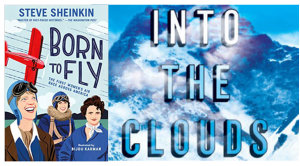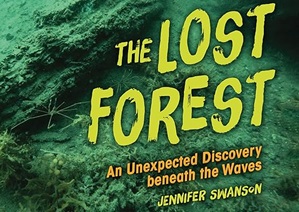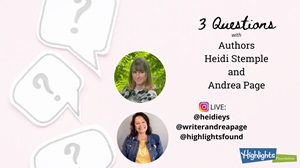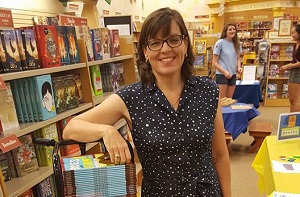We’d like to thank Tod Olson (todolson.com) and Steve Sheinkin (stevesheinkin.com) for this blog post.
How is nonfiction writing different?
Steve: At the very beginning of On Writing, Stephen King says, “This is a short book because most books about writing are filled with bullshit.” When I read that I wondered whether it applied to nonfiction writing as well as to fiction. Aside from the obvious part about being literally true, how is nonfiction writing different?
Tod: Since I’m trying to write a novel right now, I know the answer to that one: Nonfiction is easier! I say that not just because the current writing project is always the most difficult ever undertaken by a human, but because our choices as writers of nonfiction are circumscribed by our research. When every word is a product of the imagination, you have to work harder to impose your own limits, and that requires a tremendous amount of trust and conviction.
That said, I think most people underestimate the number of choices—and the amount of craft—required to write narrative nonfiction. I hope we’ll talk about this at Highlights, but I would even say it’s problematic to talk about nonfiction as “literally true.” (Who made up the title for our workshop, anyway?) We interpret sources, we impose structure, we condense time, we cherry-pick detail. What we end up with through this process is artifice, and it has a complicated relationship to “truth.” I think we can admit that and embrace the task of developing our skills as storytellers without getting nervous about “fictionalizing.” All of which is to say that you could easily fill a book full of bullshit about the craft of writing nonfiction.
Feel free to argue with me about that literally true thing. But also, if you were writing that book on the craft of nonfiction, what piece of advice would be the most essential?
Good narrative nonfiction is still largely about choices.
Steve: Well, I’m writing a nonfiction book right now, so of course I’m sure nonfiction is harder. I hear you, about having too many choices, but one of the great challenges of writing narrative nonfiction is that we’re totally reliant on sources for the raw material of our stories—the basic plot, the key scenes, the quotes and dialogue, access to our characters’ inner lives. Sometimes I want more choices! Though of course you’re right, good narrative nonfiction is still largely about choices. There’s a lot of creativity and craft. I probably think most of all about structure—where to start a story, and how to keep it moving fast. I find a story that I love, do the research, and isolate the “must-have” scenes. When I have enough of that to form a basic outline, I know I’m in business. That’s my advice: forget any romantic nonsense about the muse. Come up with a system, and work it step by step.
I’ll share my whole process at Highlights, though of course it’s just one way to do it. What about you? In writing fiction, have you found techniques that you think will help with your next nonfiction project?
Helpful techniques: structure, scene and point of view.
Tod: Yes, I’m getting really good at procrastination, which is helpful in all genres. Aside from that, there are three things:
- Structure (as you mentioned): I’ve been lucky in this regard because I’ve spent the last five years telling survival stories, which have an almost archetypal structure built in to them. I barely had to work at all.
- Scene: It’s the basic unit of narrative nonfiction. Obviously you can’t write an entire book without exposition, but I feel like if I’m not in-scene I have to ask myself why. Is whatever background or context or geeky fact I’m rambling on about really serving the story?
- Point of View: I think this is a tool people often assume is only useful to fiction writers, but I’m very conscious of what I like to think of as my narrative stance. Or in cinematic terms: Where’s the camera? Narrative nonfiction writers don’t generally write in first person, but third person still leaves you a lot of choice. I like close third person, but which sections do I give over to which character? How close do my sources allow me to get? When do I pull out for exposition and how do I craft that voice so it blends with the rest?
Speaking of exposition and narrative, I know you come from a background in educational publishing, like me—and I have to say up front that I hate it when nonfiction is referred to in the publishing world as “informational text.” But how do you think about the dual purpose of your books, i.e. to inform and tell a ripping good story?
Narrative nonfiction is that it can both entertain and inform.
Steve: I too am an avowed enemy of the “informational text” label. Might as well put our books on a shelf labeled “health food.” That said, you’re right about the “dual purpose” of the kind of books I try to write. To me, the beauty of narrative nonfiction is that it can both entertain and inform at the same time.
Yes, it’s true, I used to write history textbooks, and I’m sorry for that. But I learned a lot, and here’s the real key. It doesn’t matter how much information you put down on a page. It only matters how much information you can get back off the page. Textbooks put the information down, but it stays there (just ask my eighth grade daughter). Our challenge, as writers of narrative nonfiction, is to draw the reader into our story. The information, whatever it is, is a part of the story and becomes interesting and memorable. It’s a tricky balance to achieve–slightly different with each project–but that “dual purpose” is a very powerful thing. Sure, it’s a nerdy sort of power, but let’s embrace that!
In my writing process, I need to get the story down first. There’s never quite enough background information or context in my first drafts, but I feel like that’s what the revision process is for. Do you do something similar?
Tod: Yes. One of my trusted readers is an editor I’ve worked with on and off for 25 years. Whether I was editing or writing for her, I always aimed for lean and fast-paced and argued bitterly when she insisted I add more context. She has obviously won the battle because even though we don’t work together formally anymore, I beg her to read my drafts. It’s a constant battle trying to get perspective on your own writing, and I think there’s nothing more helpful than being forced to critique other people’s work. When I got my MFA at Vermont College, the program was built around a roundtable workshop process, and the faculty always stressed that it was important not for the advice you got on your own writing but for the exercise of reading critically and articulating your thoughts. We’re going to do our own roundtable workshops at Highlights, and I’m really looking forward to it.
Any final thoughts before we wrap it up?
Steve: There’s a quote I love in a book called Making Comics by Scott McCloud. He goes through a whole introduction of the many topics he’s going to cover–kind of like what we’ve been doing here–and then he says, “So, in short, there are no rules. And here they are.” That’s kind of my view on all teaching about writing. The best thing we can do is share our own experience–what works, what doesn’t, how we’ve gotten in and out of particular jams. We can all learn from each other, and I’m looking forward to it!






